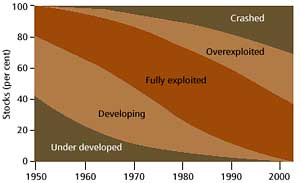



| A sea of threats Climate change abets them | |
 |
|
 |
 Oceans are highly dynamic, structured and complex systems; crucial for life on the planet. The vast resources in the oceans are not distributed evenly or randomly. For example, the largest share of marine biodiversity is found in the sea bed. Environmental conditions determining the productivity of oceans vary greatly in terms of time and space
Oceans are highly dynamic, structured and complex systems; crucial for life on the planet. The vast resources in the oceans are not distributed evenly or randomly. For example, the largest share of marine biodiversity is found in the sea bed. Environmental conditions determining the productivity of oceans vary greatly in terms of time and space Half the world's catch is caught in less than 10 per cent of the oceans. The most important fishing grounds are found on and along continental shelves within less than 200 nautical miles off the shores. These fishing grounds are also found unevenly and are very much localized
Half the world's catch is caught in less than 10 per cent of the oceans. The most important fishing grounds are found on and along continental shelves within less than 200 nautical miles off the shores. These fishing grounds are also found unevenly and are very much localized In 2004, more than half the marine landings are caught within 100 km of the coast, with depths generally less than 200 m and covering less than 7.5 per cent of the world's oceans
In 2004, more than half the marine landings are caught within 100 km of the coast, with depths generally less than 200 m and covering less than 7.5 per cent of the world's oceans Global warming and climate change pose several challenges and threats to the sustainability and productivity of oceans. In tropical shallow waters, a temperature increase of 3C by 2100 may result in annual or bi-annual bleaching episodes of coral reefs. Scientists project annual bleaching in 80-100 per cent of the world's coral reefs by 2080. This will kill corals, particularly in the Western Pacific and also in the Indian Ocean, the Persian Gulf and the Middle East and the Caribbean
Global warming and climate change pose several challenges and threats to the sustainability and productivity of oceans. In tropical shallow waters, a temperature increase of 3C by 2100 may result in annual or bi-annual bleaching episodes of coral reefs. Scientists project annual bleaching in 80-100 per cent of the world's coral reefs by 2080. This will kill corals, particularly in the Western Pacific and also in the Indian Ocean, the Persian Gulf and the Middle East and the Caribbean
 Carbon concentration in the ocean increases as atmospheric carbon goes up; causing acidification as a natural chemical process. This affects cold-water coral reefs and shell-forming organisms
Carbon concentration in the ocean increases as atmospheric carbon goes up; causing acidification as a natural chemical process. This affects cold-water coral reefs and shell-forming organisms Increasing development activities on and along coasts may impact more than 90 per cent of all inhabited coasts by 2050, and will threaten more than 80 per cent of all marine pollution
Increasing development activities on and along coasts may impact more than 90 per cent of all inhabited coasts by 2050, and will threaten more than 80 per cent of all marine pollution Increased development, pollution and climate change accelerates the spread of marine dead zones (oxygen deficient areas), many in and around primary fishing grounds, affecting fish stock. Such zones have increased from 149 in 2003 to over 200 in 2006.
Increased development, pollution and climate change accelerates the spread of marine dead zones (oxygen deficient areas), many in and around primary fishing grounds, affecting fish stock. Such zones have increased from 149 in 2003 to over 200 in 2006. | The state of the world's fishery stocks | |
 |
|
 Invasive species also threaten primary fishing grounds. Ship ballast (water that ships carry to maintain stability, drawn from ports and bays) is key factor in bringing invasive species
Invasive species also threaten primary fishing grounds. Ship ballast (water that ships carry to maintain stability, drawn from ports and bays) is key factor in bringing invasive species Lack of data and poor funding for ocean observations abet environmental degradation in the sea. Countries should take urgent measures to reduce climate and non-climate stress on the seas so that the resources are saved. This needs substantial changes in marine policies worldwide
Lack of data and poor funding for ocean observations abet environmental degradation in the sea. Countries should take urgent measures to reduce climate and non-climate stress on the seas so that the resources are saved. This needs substantial changes in marine policies worldwide We are a voice to you; you have been a support to us. Together we build journalism that is independent, credible and fearless. You can further help us by making a donation. This will mean a lot for our ability to bring you news, perspectives and analysis from the ground so that we can make change together.

Comments are moderated and will be published only after the site moderator’s approval. Please use a genuine email ID and provide your name. Selected comments may also be used in the ‘Letters’ section of the Down To Earth print edition.